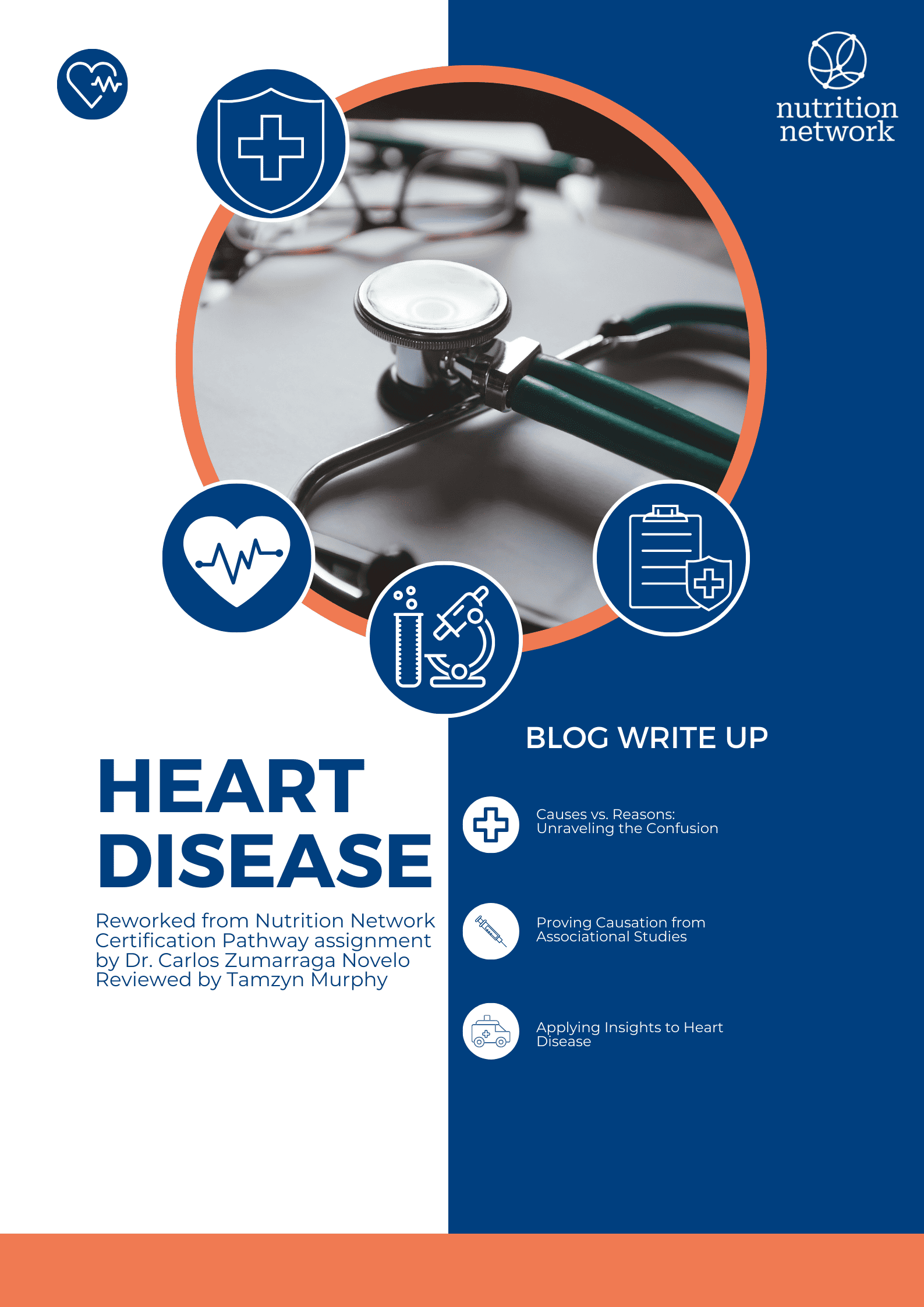Reworked from Nutrition Network Certification Pathway assignment by Dr. Carlos Zumarraga Novelo
Reviewed by Tamzyn Murphy
Understanding the intricate web of factors contributing to heart disease has long been a challenge for epidemiologists and medical researchers. One of the central issues that often perplexes the field is the distinction between causes and reasons (risk factors) for the development of this life-threatening condition. Dr. Carlos Zumarraga Novelo, a physician and scholar, sheds light on this distinction and offers valuable insights into how we can differentiate between them.
Causes vs. Reasons: Unraveling the Confusion
Epidemiologists often grapple with the conundrum of distinguishing between causes and reasons when studying diseases. It’s a critical distinction that can shape the direction of research and influence therapeutic measures. Dr. Novelo echo’s Prof Tim Noakes’ teachings during Nutrition Network’s Certification path: a cause must be both necessary and sufficient for a disease to occur. In other words, if we eliminate the cause, the disease should disappear. Risk factors, on the other hand, are variables associated with a disease but are not necessarily the sole prerequisites for its development. They are correlations that may or may not imply causation. Dr. Novelo’s key insight here is that risk factors are not causes unless proven by other means. They are reasons that can contribute to the occurrence of a disease but should not be confused with the underlying causes.
Proving Causation from Associational Studies
To establish causation from associational studies, Dr. Novelo outlines a set of criteria that researchers should consider carefully. These criteria provide a framework for evaluating the likelihood of a causal relationship:
- Strength of the association: An association with a hazard ratio (HR) below 1.5 is unlikely to be causal, while an HR above 5 is more indicative of a causal relationship.
- Consistency of the association: Multiple studies conducted by different researchers in diverse settings should consistently reveal the same association.
- Specificity: The association should be limited to specific populations, sites, and types of disease, with no connections to unrelated conditions.
- Temporality: Establishing a temporal relationship between the factor and the disease is essential. It should be clear that the factor precedes the disease’s onset.
- Biological Gradient: If there is a dose-response relationship, where higher exposure to the factor corresponds to an increased risk of the disease, it strengthens the case for causation.
- Plausibility: The suspected cause should align with current biological knowledge, even though this knowledge may evolve over time.
- Coherence: The cause-and-effect interpretation should not conflict with established facts about the disease’s natural history and biology.
- Experiment: Experimental evidence, such as preventive actions that reduce the incidence of the disease, can provide strong support for the causation hypothesis.
- Analogy: In some cases, analogies with similar evidence from other factors and diseases can lend support to the causation hypothesis.
While none of these criteria can bring indisputable evidence for or against the cause-and-effect hypothesis, they collectively help researchers make informed judgments about causation.
Applying Insights to Heart Disease
To demonstrate the practical implications of causation versus reasons, Dr. Novelo’s uses a study by Dugani SB et al. (2021) entitled Association of lipid, inflammatory, and metabolic biomarkers with age at onset for incident coronary heart disease in women. And published in the prestigious JAMA cardiology.which identifies various risk factors (reasons).
Remarkably, the study reveals that three risk factors—Type 2 diabetes, metabolic syndrome, and LPIR (lipoprotein insulin resistance) score—have a notably strong causal association with heart disease, indicated by hazard ratios above 5. These factors all share a common link: insulin resistance. This finding suggests that, instead of fixating solely on cholesterol levels (which were not significant in this study), addressing insulin resistance through a low-carb high-fat (LCHF) approach may hold promise in preventing heart disease.
However, Dr. Novelo cautions that insulin resistance may not be the sole root cause of cardiovascular disease. It can coexist with other conditions that trigger chronic vascular damage, leading to heart disease in patients without insulin resistance.
Conclusion
Distinguishing between causes and reasons (risk factors) is crucial when unraveling the complexities of diseases like heart disease. Dr. Carlos Zumarraga Novelo’s insights provide a valuable framework for researchers and practitioners to navigate this distinction. Understanding the criteria for proving causation from associational studies can lead to more accurate diagnoses, targeted interventions, and improved prevention strategies.
References:
- Noakes TD. Presentation. Nutrition Network Medical Certification Program 2022.
- Westman E. Presentation: Cholesterol. Should you take statins. 2022 Jun.
- Dugani SB, Moorthy MV, Li C, Demler OV, Alsheikh-Ali AA, Ridker PM, Glynn RJ, Mora S. Association of lipid, inflammatory, and metabolic biomarkers with age at onset for incident coronary heart disease in women. JAMA cardiology. 2021 Apr 1;6(4):437-47.
- Hill AB. The environment and disease: association or causation?. Journal of the Royal Society of Medicine. 2015 Jan;108(1):32-7.





More Stories
The One Thing You Should Never, Ever Do if You Have Insulin Resistance and Want to Lose Weight
Tuna Salad Lunch Box – JSHealth
Advanced Wellness Course – Heart Health